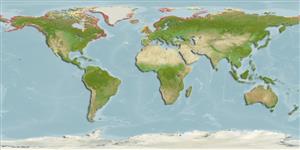Common names from other countries
Environment: milieu / climate zone / depth range / distribution range
Ecologie
; diepteverspreiding 0 - 100 m (Ref. 116516). Polar
Arctic, Northern Atlantic and Pacific Ocean. Mostly polar, but also subtropical and boreal.
Length at first maturity / Size / Gewicht / Leeftijd
Maturity: Lm ? range ? - ? cm Max length : 0.9 cm WD mannelijk/geslacht niet bekend; (Ref. 2992)
Bell measures 10 mm high and wide; manubrium varies from pink to white, with 4 very distinctive dichotomously-branched oral tentacles; 4 radial canals; 4 tentacle bulbs, each bearing similar tentacles (<60) and with its own dark ocellus; transparent umbrella (Ref. 2376).
Neritic (Ref. 120409). Found on bay and nearshore (Ref. 116013). Colonial (Ref. 19). Fairly short-lived, occurring in late spring or summer and feeding especially on barnacle nauplii; preyed on by Aequorea sp. and other medusivorous hydromedusae (Ref. 2376). Also on hard substrate (Ref. 116013).
Life cycle and mating behavior
Geslachtsrijpheid | Voortplanting | Kuitschieten | Eieren | Fecundity | Larven
Species exhibits both asexual and sexual reproduction by budding during hydroid stage and release of gametes in medusae stages (Ref. 1663, p. 12, 16).
Cairns, S.D., D.R. Calder, A. Brinckmann-Voss, C.B. Castro, D.G. Fautin, P.R. Pugh, C.E. Mills, W.C. Jaap, M.N. Arai, S.H.D. Haddock and D.M. Opresko. 2003. (Ref. 1663)
Status op de Rode Lijst van het IUCN (Ref. 130435)
Status bij CITES (Ref. 108899)
Not Evaluated
Not Evaluated
Gebruik door de mens
| FishSource |
Tools
Internet-bronnen
Estimates based on models
Kwetsbaarheid
Low vulnerability (10 of 100).
Prijsklasse
Unknown.
